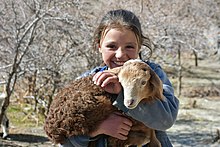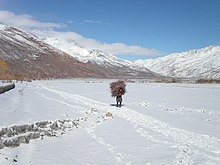Wakhi people
 A Wakhi girl from the village of Zood Khun, Chapursan Valley, Pakistan. | |
| Total population | |
|---|---|
| ~ 50,000–58,000[1][2] | |
| Regions with significant populations | |
| Afghanistan, China, Pakistan, Tajikistan | |
| Languages | |
| Wakhi | |
| Religion | |
| Islam (Ismaili Shia) |
The Wakhi people, or the Khik,[3] are an ethnic group living in adjacent, remote regions of Afghanistan, Tajikistan, Pakistan, and China. They are predominantly centered in Afghanistan's Wakhan Corridor, the northern-most part of Pakistan's Gilgit-Baltistan, the Gorno-Badakhshan region of Tajikistan, and the southwestern region of China's Xinjiang.[4] They are native speakers of Wakhi, an Indo-European language of the Iranian branch.
Name
The Wakhi people refer to themselves as Khik and to their language as Khik zik.[3] The exonym Wakhī, which is given to them by their neighbors, is based on Wux̌, the local name of the region of Wakhan, deriving from *Waxšu, the old name of the Oxus River (Amu Darya), which is a major river formed by the junction of the Vakhsh and Panj rivers on the border between Tajikistan and Afghanistan.[1]
Demographics


Ethnic Wakhi-speakers have a total population of about 50,000–58,000.[1][2] The population is divided between four countries: Afghanistan, Tajikistan, Pakistan, and China's Xinjiang. Due to wars, heavy taxation, and oppression by the local rulers, the Wakhi people have migrated south to form the Wakhi settlements present today in northwestern Pakistan.[5]
In China, the Wakhi people, together with the Sarikoli people, are officially recognized as "Tajiks", with ethnic-minority autonomous status. In Afghanistan, they are officially called "Pamiri". In Tajikistan, they are recognized by the state as "Tajiks", but self-identify as "Pamiri". In Pakistan, they refer to themselves as "Pamiri" or "Gujali".[citation needed]
The Wakhi predominantly adhere to Nizari Ismaili Shia Islam, which is regarded as their ethnic religion, and are followers of the Aga Khan.[3][6][7]
Economy
The Wakhi are primarily nomadic, depending on their herds of yaks and horses.[8] They often have two residences—one for winter and one for summer. Their houses are built of stone and sod.[3]
Cultural preservation
Activists and researchers have been working to preserve and record the language of the Wakhi people, and have developed Wakhi orthographies using the Arabic, Cyrillic, and Latin scripts.[4]
In 1990, the Gojali Wakhis of Pakistan established the "Wakhi Tajik Cultural Association", which aimed to preserve, document, and publish their "local culture". The association introduced a script that was applied into linguistic and literary textbooks, and organized cultural festivals. Radio Pakistan's Radio Gilgit also aired a daily Wakhi-language program named Bam-e Dunya ("Roof of the World").[9][10]
See also
Notes and references
- ^ a b c "Iranian languages". Encyclopædia Britannica. Retrieved 14 July 2018.
- ^ a b "Wakhi". Ethnologue. Retrieved 14 July 2018.
- ^ a b c d Kreutzmann, Hermann (3 September 2003). "Ethnic minorities and marginality in the Pamirian Knot: survival of Wakhi and Kirghiz in a harsh environment and global contexts". The Geographical Journal. 169. Blackwell Publishing: 215–235.
- ^ a b "Wakhi". Endangered Language Alliance. Retrieved 14 July 2018.
- ^ Shafiq, Nadeem. "The Wakhi Community Settlements in Northern Pakistan". Journal of Political Studies: 1.
The major Wakhi Community settlements in Pakistan are found in Chitral and Gilgit-Baltistan areas. Their ancestors fled to these regions due to a couple of reasons including wars, heavy taxation and oppression by the local rulers and Afghan officials.
- ^ West, Barbara (2008). Encyclopedia of the Peoples of Asia and Oceania. Facts on File. ISBN 0816071098.
- ^ Shahrani, M. Nazif Mohib (2002). The Kirghiz and Wakhi of Afghanistan. Seattle: University of Washington Press. p. 216. ISBN 0-295-98262-4.
- ^ "Khyber Pakhtunkhwa: People and Tribes". Government of the Khyber Pakhtunkhwa. Archived from the original on 16 March 2015.
{{cite web}}: Unknown parameter|deadurl=ignored (|url-status=suggested) (help) - ^ Brower, Barbara; Johnston, Barbara Rose (2016). Disappearing Peoples?: Indigenous Groups and Ethnic Minorities in South and Central Asia. Routledge. p. 184.
- ^ Windfuhr, Gernot (2013). The Iranian Languages. Routledge. p. 826.
Bibliography
- Felmy, Sabine (1996). The Voice of the Nightingale: A Personal Account of the Wakhi Culture in Hunza. New York: Oxford University Press. ISBN 0-19-577599-6.
- Shahrani, M. Nazif (1979). The Kirghiz and Wakhi of Afghanistan: Adaptation to Closed Frontiers and War. Seattle: University of Washington Press. ISBN 0-295-95669-0.; 1st paperback edition with new preface and epilogue (2002), ISBN 0-295-98262-4.
External links
- "Photos From Afghanistan: Natural Beauty, Not War". NPR. 29 September 2010. (slideshow)
- "A small village in Gilgit-Baltistan is making big efforts to keep its music alive". Scroll.in. 8 November 2016.
